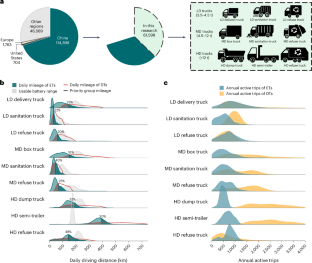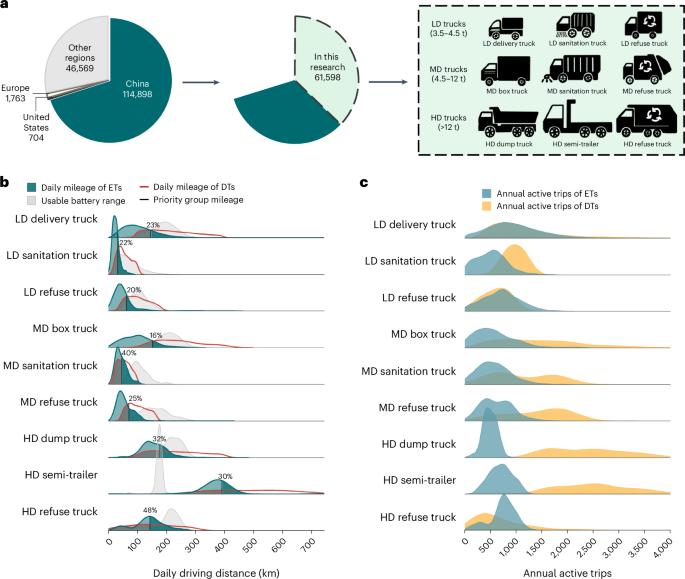运营大数据揭示卡车电气化的挑战与机遇
IF 49.7
1区 材料科学
Q1 ENERGY & FUELS
引用次数: 0
摘要
卡车电气化是实现零排放运输的一大挑战。在此,我们收集了中国 61598 辆电动卡车的全年记录。与柴油卡车相比,目前电动卡车的使用率明显偏低。23%的电动运货卡车和 30% 的电动半挂牵引车可以实现与柴油卡车的一对一替代,而平均需要 3.8 辆电动运货卡车和 3.6 辆电动半挂牵引车才能满足单独一辆柴油卡车的运输需求。对于能够一对一替代的柴油卡车,电动卡车的成本和生命周期内的二氧化碳排放量分别降低了 15% 至 54%,以及 1% 至 49%。使用模式、车辆技术和充电基础设施的改进可以提高电气化的可行性,带来成本和脱碳效益。通过优化使用提高电池能量密度,可使 85% 以上的柴油半挂车实现一对一电气化。此外,在使用清洁电力的情况下,2030 年大多数中国电动卡车的预期生命周期二氧化碳排放量将低于柴油卡车。本文章由计算机程序翻译,如有差异,请以英文原文为准。


Challenges and opportunities in truck electrification revealed by big operational data
The electrification of trucks is a major challenge in achieving zero-emission transportation. Here we gathered year-long records from 61,598 electric trucks in China. Current electric trucks were found to be significantly underutilized compared with their diesel counterparts. Twenty-three per cent of electric delivery trucks and 30% of semi-trailers could achieve one-on-one replacement with diesel counterparts, while on average 3.8 electric delivery trucks and 3.6 electric semi-trailers are required to match the transportation demand that is served by one diesel truck separately. For diesel trucks that are capable of one-on-one replacement, electric trucks have 15–54% and 1–49% reductions in cost and life-cycle CO2 emissions, respectively. Enhancements in usage patterns, vehicle technologies and charging infrastructure can improve electrification feasibility, yielding cost and decarbonization benefits. Increased battery energy densities with optimized usage can make one-on-one electrification feasible for more than 85% of diesel semi-trailers. In addition, with cleaner electricity, most Chinese electric trucks in 2030 will have lower expected life-cycle CO2 emissions than diesel trucks. Truck electrification is an important but challenging task for decarbonization. Here the authors investigate usage data from >60,000 electric trucks to pose category-tailored strategies for overcoming the hurdles of feasibility, cost and decarbonization in this sector.
求助全文
通过发布文献求助,成功后即可免费获取论文全文。
去求助
来源期刊

Nature Energy
Energy-Energy Engineering and Power Technology
CiteScore
75.10
自引率
1.10%
发文量
193
期刊介绍:
Nature Energy is a monthly, online-only journal committed to showcasing the most impactful research on energy, covering everything from its generation and distribution to the societal implications of energy technologies and policies.
With a focus on exploring all facets of the ongoing energy discourse, Nature Energy delves into topics such as energy generation, storage, distribution, management, and the societal impacts of energy technologies and policies. Emphasizing studies that push the boundaries of knowledge and contribute to the development of next-generation solutions, the journal serves as a platform for the exchange of ideas among stakeholders at the forefront of the energy sector.
Maintaining the hallmark standards of the Nature brand, Nature Energy boasts a dedicated team of professional editors, a rigorous peer-review process, meticulous copy-editing and production, rapid publication times, and editorial independence.
In addition to original research articles, Nature Energy also publishes a range of content types, including Comments, Perspectives, Reviews, News & Views, Features, and Correspondence, covering a diverse array of disciplines relevant to the field of energy.
 求助内容:
求助内容: 应助结果提醒方式:
应助结果提醒方式:


